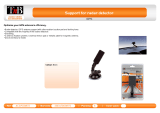
NOTE: The manufacturer is not responsible for any radio or TV interference
caused by unauthorized modifications to this equipment. Such modifications
could void the user’s authority to operate the equipment.
Copyright information
© 2007 Cheetah Advanced Technologies Ltd, Scotland. All rights
reserved.
“Cheetah” and “Trinity” are registered trademarks of Cheetah Advanced
Technologies Ltd, Scotland. All other trademarks are the property of their
respective owners.
Cheetah Advanced Technologies Ltd has made every effort to ensure that
all the information contained in this manual is accurate and reliable;
however, the information is subject to change without notice. Cheetah
Advanced Technologies Ltd shall not be liable for technical or editorial
errors or omissions contained herein; nor for incidental or consequential
damages resulting from the performance or use of this material. This
document contains information protected by copyright. No part of this
document may be photocopied or reproduced in any form without prior
written consent from Cheetah Advanced Technologies Ltd.
Limited Warranty
Cheetah Advanced Technologies Ltd. Warrant our products against all
defects in materials and workmanship for a period of one year from
the date of the original purchase, subject to the following terms and
conditions.
This warranty is limited to the original owner, and is Non-Transferable.
This warranty does not apply if the serial number has been removed or
is unreadable or if the product has been subjected to physical abuse,
improper installation, modification or internal examination.
To obtain warranty service, the product must be returned, insured and
shipping prepaid, to Cheetah Advanced Technologies Ltd., at the address
shown, in its original packaging or a suitable alternative, together with
a written description of the problem, proof of purchase and a return
shipping address.
The sole responsibility of Cheetah Advanced Technologies Ltd under
this warranty is limited to repair or, at discretion, replacement of the
product.
Cheetah Advanced Technologies disclaims all other warranties, expressed
or implied, including warranties of fitness for any particular purpose or
merchantability.
Cheetah Advanced Technologies Ltd accept no liability for any direct,
indirect or consequential claim arising from the use or misuse of this
product or from any incident arising from an installation that inhibits the
correct operation of an airbag or any other vehicle system.
The use of Cheetah software products is governed by a license agreement.
This license contains a limitation of liability. You can review the license
conditions at www.speedcheetah.com
Cheetah Advanced Technologies Ltd. declares that this product
is in compliance with the essential requirements and other
relevant provisions of Directive 1999/5/EC.
This device complies with Part 15 of the FCC Rules.
Operation is subject to the following two conditions:
(1) this device may not cause harmful interference,
and (2) this device must accept any interference
received, including interference that may cause
undesired operation
18



















